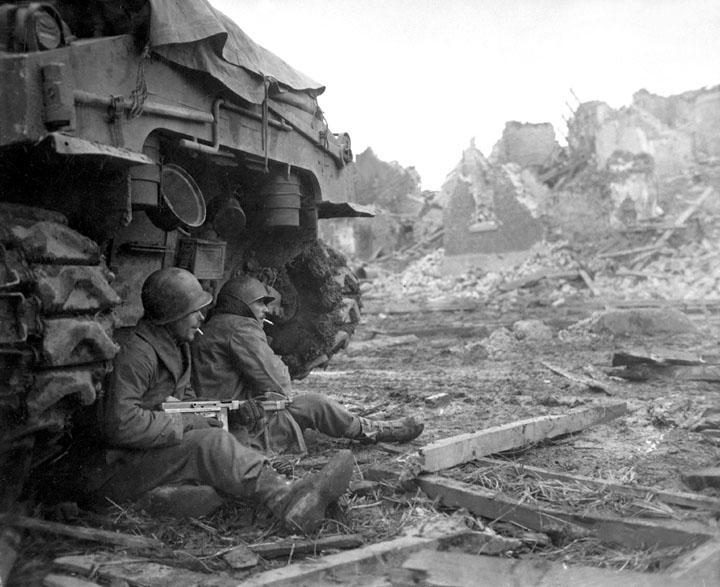G.I.'s take cover from artillery fire in the town of Geich, Germany. December 11, 1944
For the US Army the fall of 1944 represented one long grinding struggle along Germany's western border. A struggle highlighting a surprising manpower shortage within the US Army's frontline rifle companies at a time when the Third Reich hovered on collapse. This manpower shortage stemmed from a number of reasons. Perhaps most prominently was the American method of waging war.
The 1944-45 era US Army deployed an inordinate number of specialized artillery, tank destroyer, anti-aircraft and other such units. All of these units required considerable manpower to maintain in the field and represented a product of General of the US Army George C. Marshal's earlier decisions to build an army capable of fighting the 1940 era German army and blitz. By 1944 however, the German army was a mere shadow of its former self and had largely been reduced to fighting in static defensive positions. Rooting out such defenders required both manpower and firepower. Yet in the US Army firepower reigned supreme. Thus, the limited number of rifle companies were forced to bear the lion's share of the combat burden, and absorbed a huge percentage of both combat and non-combat losses. In addition, Marshal's decision to limit the US Army's size, meant American infantry divisions remained permanent fixtures at the front.
As a result, the casualties in the frontline divisions had reached such severe levels General Omar Bradley spent much of his December 16, 1944 meeting with Dwight Eisenhower addressing the problems afflicting his 12th Army Group. The 12th Army Group included 31 divisions, out of 43 American divisions deployed in Europe during December 1944; meaning Bradley's command ranked as the largest Army in U.S. history. In spite of this army's size, nearly all of its divisions fought under manned by the late fall of 1944. The US Army in the European Theater of Operations, ETO, was a full 17,000 men under strength in the front line infantry companies alone. More specifically, in just five weeks fighting, the 12th Army Group suffered 64,000 battle casualties and another 12,000 men were lost to trench foot. The majority of these losses occurred in the First and Ninth Armies north of the Ardennes. Accordingly, the US First and Ninth Armies fought under increasing strain as fall turned to winter and their aggregate 14 under strength divisions lined up across a 55-mile front. In the Huertgen Forest alone, a series of American infantry divisions suffered 33,000 casualties in total.
The composition of the average US Infantry Divisions only made the casualties endured even more prohibitive. Approximately 3,240 riflemen staffed a typical US Infantry Division of 14,000 men. These 3,240 men not only carried the division's combat punch but also suffered most of the casualties endured by the parent division. Only 14 percent of the US Army's entire strength in Europe served in the infantry ranks but the infantry suffered 70 percent of the casualties, the loss rate in infantry platoons averaged 90 percent.
Even Patton's seemingly dominant Third Army staggered across the German border; a by-product of pushing through stiff German resistance, particularly along the Moselle River and near Metz. The Third Army fought nearly 15% under strength in its infantry battalions in December 1944. Moreover, even though it may not sound significant that the quarter million man Third Army fought 11,000 riflemen short during November and December 1944; these 11,000 men equaled enough riflemen to fill nearly an entire infantry Corps. Furthermore, on a sustained basis, i.e. from September 1, 1944 up to December 16, 1944, the Third Army lost 53,182 men - almost equaling the losses of the First and Ninth Armies combined.
Picture Courtesy of US National Archives (111-SC-197261)


